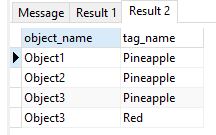Json received from the server has this form.
[
{
"id": 1103333,
"name": "James",
"tagA": [
"apple",
"orange",
"grape"
],
"tagB": [
"red",
"green",
"blue"
],
"tagC": null
},
{
"id": 1103336,
"name": "John",
"tagA": [
"apple",
"pinapple",
"melon"
],
"tagB": [
"black",
"white",
"blue"
],
"tagC": [
"London",
"New York"
]
}
]
An object can have multiple tags, and a tag can be associated with multiple objects.
In this list, I want to find an object whose tagA is apple or grape and tagB is black.
This is the first table I used to write.
create table response(id integer primary key, name text not null, tagA text,
tagB text, tagC text)
select * from response where (tagA like '%apple%' or tagA like '%grape%') and (tagB like '%black%')
This type of table design has a problem that the search speed is very slow because it does not support the surface function of the fts function when using ORM library such as Room.
The next thing I thought about was to create a table for each tag.
create table response(id integer primary key, name text not null)
create table tagA(objectID integer, value text, primary key(objectID, value))
create table tagB(objectID integer, value text, primary key(objectID, value))
create table tagC(objectID integer, value text, primary key(objectID, value))
select * from response where id in ((select objectId from tagA where value in ('apple','grape'))
intersect
(select objectId from tagB where value in 'black'))
This greatly increases the insertion time and the capacity of the APK (roughly twice as much per additional table), but the search speed is far behind that of the FTS virtual table.
I want to avoid this as much as I use FTS tables because there are more things I need to manage myself.
There are a lot of things I missed (index etc.) but I can not figure out what it is.
How can I optimize the database without using the FTS method?



